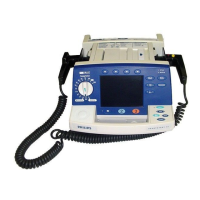Defibrillation Therapy
1-6 Introduction
Indications for Manual Defibrillation Therapy
Asynchronous defibrillation is the initial treatment for ventricular fibrillation
and ventricular tachycardia, in patients who are pulseless and unresponsive.
The SMART Biphasic waveform utilized in the M4735A Heartstream XL
Defibrillator/Monitor has undergone clinical testing in adults. These trials
support the waveform’s effectiveness for defibrillation of ventricular
tachyarrhythmias at the 150J setting.
In manual mode operation, the M4735A Heartstream XL Defibrillator/Moni-
tor incorporates some user selectable lower energy levels that were not used in
the clinical trials.
There are currently no clinical studies related to the use of the SMART
Biphasic waveform in pediatric applications or in direct defibrillation of the
heart during open chest surgery.
Contraindications for Manual Defibrillation Therapy
Asynchronous defibrillation therapy is contraindicated in patients that exhibit
one or any combination of the following:
l
Responsiveness
l
Spontaneous breathing
l
Palpable pulse
Precautions for Manual Defibrillation Therapy
Defibrillating asystole can inhibit the recovery of natural pacemakers in the
heart and completely eliminate any chance of recovery. Asystole should not
be routinely shocked.

